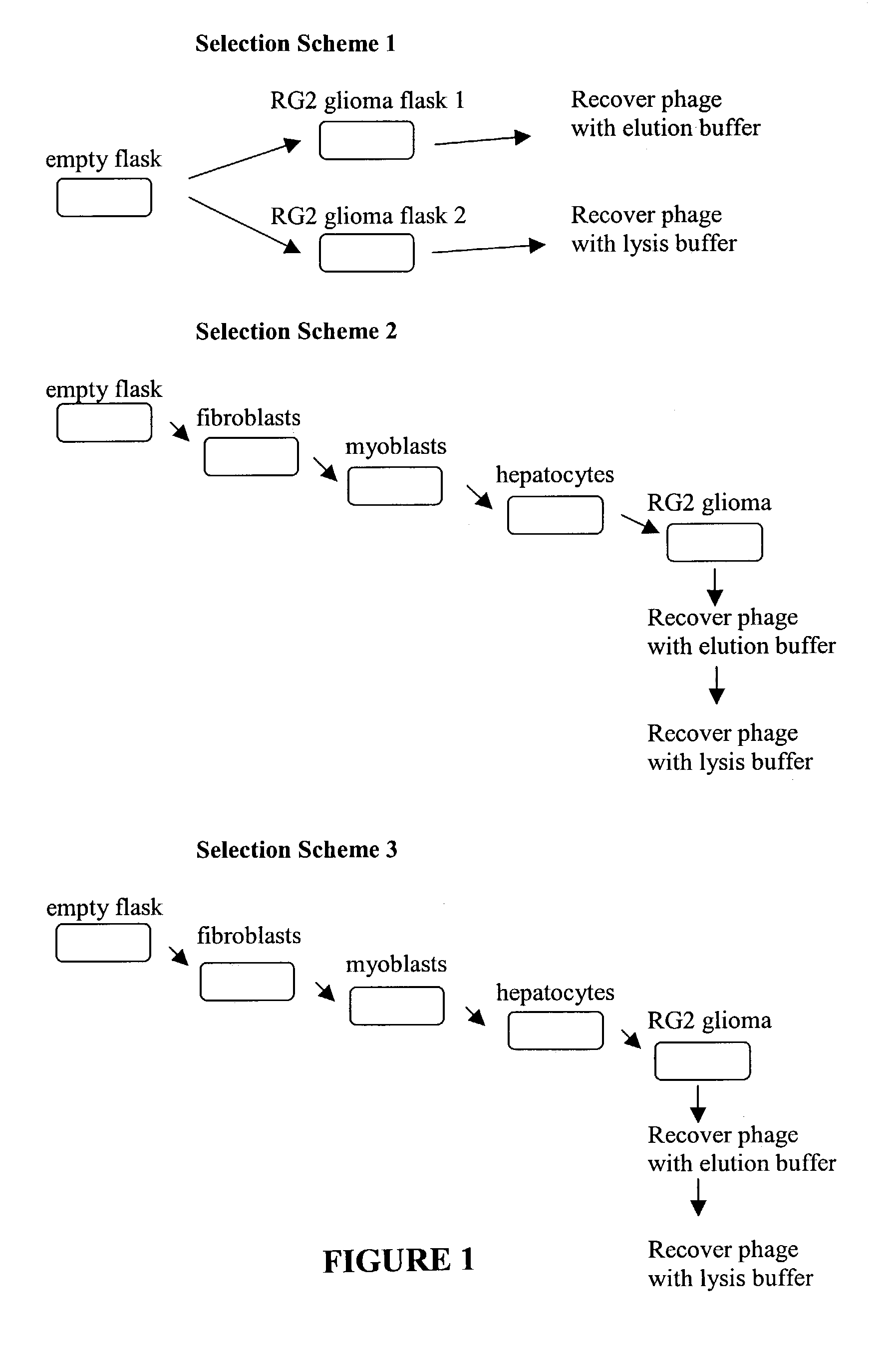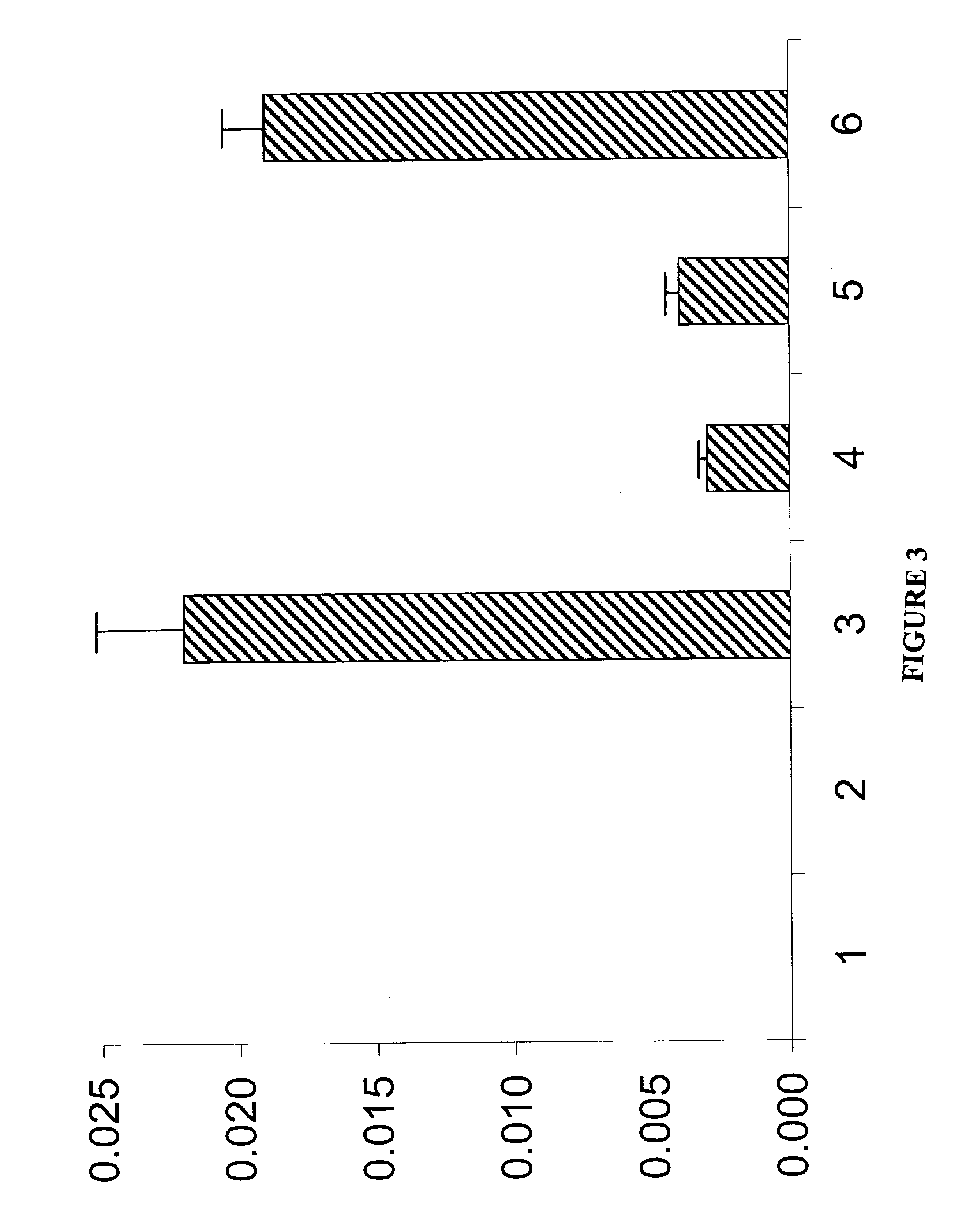Peptides for recognition and targeting of GLIAL cell tumors
a glial cell tumor and peptide technology, applied in the field of identification of peptides for the recognition, isolation, characterization, and targeting of glial cell tumors, can solve the problems of obstructing, destroying adjacent brain tissue, unable rarely being able to completely remove the tumor, etc., to achieve high specificity
- Summary
- Abstract
- Description
- Claims
- Application Information
AI Technical Summary
Benefits of technology
Problems solved by technology
Method used
Image
Examples
example 1
Selection Schemes for Affinity Selection of Phage
[0074]Selection of phage clones which bind to glioma cell-specific receptors was performed as described by Barry et al. (1996) Nat. Med. 2: 299–305, with the modifications described below. Generally, the selection of phage began with depletion or negative selection of clones that bound readily to plastic by incubating a library aliquot in 25 cm2 plastic flasks. Selection Schemes 2 and 3 incorporated additional depletion or negative selection steps. In Selection Schemes 1 and 2, a library aliquot containing an estimated 100 copies of each phage clone was used, while in Selection Scheme 3, a library aliquot containing an estimated 10 copies of each phage clone was used.
[0075]Defined Selection Schemes were developed to identify peptides that bound to or preferentially bound to glioma cells. Both the RG2 (CRL-2433) and F98 (CRL-2397) rat glioma cell lines (available from the American Type Culture Collection (ATCC), 10801 University Boulev...
example 2
Identification of Cell Surface Markers to Which Synthetic Peptides Bind
[0126]Experiments were performed to isolate and purify the RG2-cell-specific protein that was responsible for binding of the ELRGDSLP phage clone to glioma cells. The basic approach was to perform precipitation of RG2 cell membrane proteins by using the phage clone to form an affinity matrix.
[0127]To prepare the RG2 cell membrane proteins, RG2 glioma cells were grown in 25 cm2 tissue culture flasks. The growing medium was removed from the flasks and cells were collected in PBS buffer containing protease inhibitors. Cells were then pelleted by centrifugation and lysed with octylglucoside buffer (10 mM Tris-HCl, pH 7.5, 140 mM NaCl, 10 mM octylglucoside (Sigma), and protease inhibitor cocktail (Sigma); 5 ml per flask). The cell lysate was clarified by centrifugation and the supernatant containing cell membrane proteins was then used for isolation of glioma-specific receptor proteins.
[0128]Cross-linked phage were pr...
example 3
Therapy in an Animal Model
i. Induction of Model Glioma in Experimental Animals
[0132]Fischer 344 rats are injected with RG2 cells so as to induce the formation of malignant gliomas. At various times, brain biopsies are taken from representative rats from the population. Portions of these biopsies are frozen and evaluated histochemically. Tissue samples are homogenized and assayed for the presence or absence of cell surface markers that bind to an array of synthetic peptides.
ii. In Vivo Delivery of Pharmaceuticals
[0133]Synthetic peptides are conjugated to methotrexate to form a pharmaceutical composition. Each test rat is sedated, and an intraarterial catheter placed in the internal carotid artery so as to deliver the pharmaceutical composition directly to the rat's brain as a slow injection. If the location of the tumor is known, then intratumoral injections are preferred. During injection, the rats are monitored for signs associated with adverse reactions such as anaphylaxis, and sh...
PUM
| Property | Measurement | Unit |
|---|---|---|
| time | aaaaa | aaaaa |
| pH | aaaaa | aaaaa |
| volume | aaaaa | aaaaa |
Abstract
Description
Claims
Application Information
 Login to View More
Login to View More - R&D
- Intellectual Property
- Life Sciences
- Materials
- Tech Scout
- Unparalleled Data Quality
- Higher Quality Content
- 60% Fewer Hallucinations
Browse by: Latest US Patents, China's latest patents, Technical Efficacy Thesaurus, Application Domain, Technology Topic, Popular Technical Reports.
© 2025 PatSnap. All rights reserved.Legal|Privacy policy|Modern Slavery Act Transparency Statement|Sitemap|About US| Contact US: help@patsnap.com



